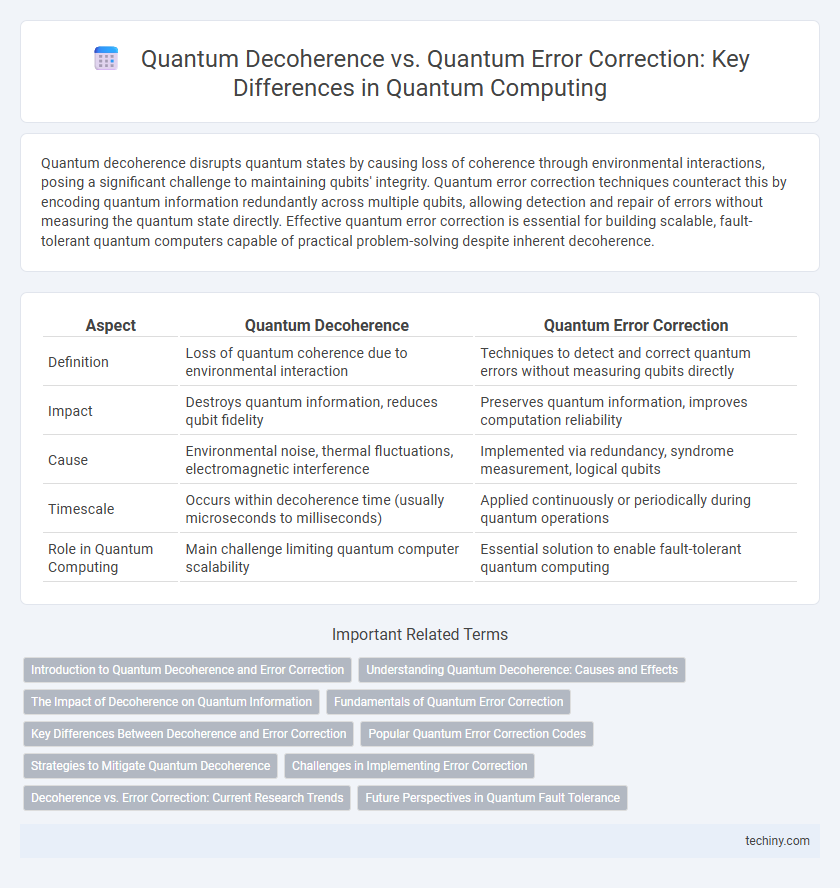Quantum decoherence disrupts quantum states by causing loss of coherence through environmental interactions, posing a significant challenge to maintaining qubits' integrity. Quantum error correction techniques counteract this by encoding quantum information redundantly across multiple qubits, allowing detection and repair of errors without measuring the quantum state directly. Effective quantum error correction is essential for building scalable, fault-tolerant quantum computers capable of practical problem-solving despite inherent decoherence.
Table of Comparison
| Aspect | Quantum Decoherence | Quantum Error Correction |
|---|---|---|
| Definition | Loss of quantum coherence due to environmental interaction | Techniques to detect and correct quantum errors without measuring qubits directly |
| Impact | Destroys quantum information, reduces qubit fidelity | Preserves quantum information, improves computation reliability |
| Cause | Environmental noise, thermal fluctuations, electromagnetic interference | Implemented via redundancy, syndrome measurement, logical qubits |
| Timescale | Occurs within decoherence time (usually microseconds to milliseconds) | Applied continuously or periodically during quantum operations |
| Role in Quantum Computing | Main challenge limiting quantum computer scalability | Essential solution to enable fault-tolerant quantum computing |
Introduction to Quantum Decoherence and Error Correction
Quantum decoherence occurs when a quantum system interacts with its external environment, causing the loss of quantum coherence and effectively collapsing superposition states into classical mixtures. Quantum error correction techniques work to protect quantum information from decoherence by encoding logical qubits into entangled states distributed across multiple physical qubits, enabling the detection and correction of errors without directly measuring quantum states. Understanding the balance between mitigating decoherence and implementing robust error correction codes is essential for advancing reliable quantum computing architectures.
Understanding Quantum Decoherence: Causes and Effects
Quantum decoherence occurs when a quantum system loses its coherence due to interactions with the external environment, causing the fragile quantum states to collapse into classical states. This phenomenon severely limits the performance and scalability of quantum computers by introducing errors during computation. Quantum error correction techniques are designed to detect and rectify these errors by encoding quantum information in a way that preserves coherence despite environmental disturbances.
The Impact of Decoherence on Quantum Information
Quantum decoherence significantly disrupts quantum information by causing the loss of quantum coherence, leading to errors in qubits that degrade computational accuracy. Effective quantum error correction codes are essential to detect and mitigate these errors, preserving the integrity of quantum data despite environmental noise. The balance between minimizing decoherence and implementing robust error correction schemes remains critical for advancing reliable quantum computing technologies.
Fundamentals of Quantum Error Correction
Quantum error correction (QEC) is essential for maintaining coherence in quantum computing by protecting quantum information from errors caused by quantum decoherence. QEC relies on encoding qubits into entangled logical qubits using error-correcting codes like the Shor code or surface code, enabling detection and correction of bit-flip and phase-flip errors without measuring the quantum state directly. These techniques are fundamental for scalable and fault-tolerant quantum computation, overcoming the fragile nature of quantum states against environmental noise.
Key Differences Between Decoherence and Error Correction
Quantum decoherence refers to the loss of quantum coherence caused by the interaction of a quantum system with its environment, which leads to the collapse of quantum states into classical ones. Quantum error correction, on the other hand, involves techniques and algorithms designed to detect and correct errors without directly measuring the quantum state, thereby preserving quantum information. The key difference lies in decoherence being a fundamental physical process that degrades quantum information, while error correction is an engineered method that actively combats this degradation to maintain computational accuracy.
Popular Quantum Error Correction Codes
Quantum decoherence undermines quantum bit stability, posing a key challenge for reliable quantum computing. Popular quantum error correction codes such as the Surface Code, Shor Code, and Steane Code enable detection and correction of errors caused by decoherence, preserving qubit coherence. These codes leverage redundancy and entanglement to maintain fault tolerance in noisy intermediate-scale quantum devices.
Strategies to Mitigate Quantum Decoherence
Quantum decoherence, a significant challenge in quantum computing, causes qubits to lose coherence and quantum information, leading to errors during computation. Strategies to mitigate quantum decoherence include implementing quantum error correction codes, such as surface codes and concatenated codes, which detect and correct errors without measuring the quantum state directly. Hardware improvements like using topological qubits and dynamically decoupling qubits from environmental noise further enhance coherence times and computational reliability.
Challenges in Implementing Error Correction
Quantum decoherence poses a significant challenge to quantum error correction by causing rapid loss of qubit coherence, leading to errors that are difficult to detect and correct in real-time. Implementing quantum error correction requires complex encoding schemes such as surface codes, which demand a large number of physical qubits to represent a single logical qubit, greatly increasing system overhead. The synchronization of error detection and correction operations under the influence of noisy quantum gates and limited qubit connectivity further complicates scalable quantum computing architectures.
Decoherence vs. Error Correction: Current Research Trends
Quantum decoherence poses a significant obstacle to maintaining qubit coherence in quantum computing systems, leading to loss of quantum information. Current research trends emphasize developing advanced quantum error correction codes, such as surface codes and concatenated codes, to mitigate decoherence effects and enhance fault-tolerant quantum computation. Experimental efforts focus on optimizing error correction protocols in noisy intermediate-scale quantum (NISQ) devices to improve qubit fidelity and coherence times.
Future Perspectives in Quantum Fault Tolerance
Quantum decoherence remains the primary obstacle in achieving robust quantum fault tolerance, as it disrupts qubit coherence essential for accurate quantum computations. Advanced quantum error correction codes, such as surface codes and bosonic codes, are being optimized to mitigate decoherence effects and enhance error thresholds. Future perspectives emphasize scalable fault-tolerant architectures that integrate real-time error diagnostics and adaptive correction protocols to enable practical quantum computing.
quantum decoherence vs quantum error correction Infographic

 techiny.com
techiny.com